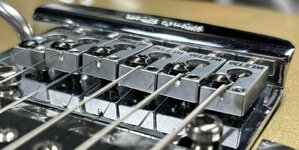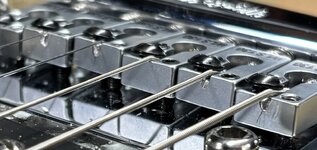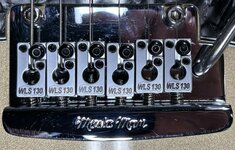nervous
Well-known member
Having some unusual difficulty in intonating the Silo Special and has a question for those in the know since I rarely work with a full floating trem bridge. Do you immobilize the bridge when doing the intonation to remove the possible bridge motion when fretting and testing? I know that is likely s dumb question since that motion is so small but I am finding myself moving the saddles further and further back many to the point they can't practically go back any further because they're hitting the back of the bridge plate or covering the string through holes. So in a frustrated move to see what happens I moved all the saddles forward into the more 'normal' range and found that, as expected, they all play a tad sharp but not as much as I would have expected so that didn't make sense. And it sounds find to my ears tuning wise. So I am a bit stumped.
Another odd thing I have happen is that when the low E reads in tune open (confirmed with the 12th fret harmonic for reference) that string plays sharp when fretted, and yes, the nut slot height is good. but when I detune that string just a hair and teh tuner reads just a tad flat things come nicely into tune. Also baffling. Now I have had other guitars where they was a string that had to be tweaked a bit after an accurate tuner reading so perhaps this is a case of that? Just an imperfect idiosyncrasy?
Another odd thing I have happen is that when the low E reads in tune open (confirmed with the 12th fret harmonic for reference) that string plays sharp when fretted, and yes, the nut slot height is good. but when I detune that string just a hair and teh tuner reads just a tad flat things come nicely into tune. Also baffling. Now I have had other guitars where they was a string that had to be tweaked a bit after an accurate tuner reading so perhaps this is a case of that? Just an imperfect idiosyncrasy?






